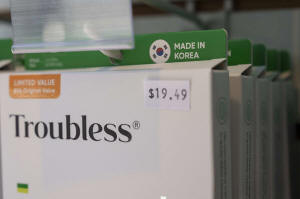Tariffs threaten Asian beauty product boom in US
[July 28, 2025] By
MAE ANDERSON
NEW YORK (AP) — When Amrita Bhasin, 24, learned that products from South
Korea might be subject to a new tax when they entered the United States,
she decided to stock up on the sheet masks from Korean brands like
U-Need and MediHeal she uses a few times a week.
“I did a recent haul to stockpile,” she said. “I bought 50 in bulk,
which should last me a few months.”
South Korea is one of the countries that hopes to secure a trade deal
before the Aug. 1 date President Donald Trump set for enforcing
nation-specific tariffs. A not-insignificant slice of the U.S.
population has skin in the game when it comes to Seoul avoiding a 25%
duty on its exports.
Asian skin care has been a booming global business for a more than a
decade, with consumers in Europe, North and South America, and
increasingly the Middle East, snapping up creams, serums and balms from
South Korea, Japan and China.
In the United States and elsewhere, Korean cosmetics, or K-beauty for
short, have dominated the trend. A craze for all-in-one “BB creams” — a
combination of moisturizer, foundation and sunscreen — morphed into a
fascination with 10-step rituals and ingredients like snail mucin,
heartleaf and rice water.

Vehicles and electronics may be South Korea's top exports to the U.S. by
value, but the country shipped more skin care and cosmetics to the U.S.
than any other last year, according to data from market research company
Euromonitor. France, with storied beauty brands like L'Oreal and Chanel,
was second, Euromonitor said.
Statistics compiled by the U.S. International Trade Commission, an
independent federal agency, show the U.S. imported $1.7 billion worth of
South Korean cosmetics in 2024, a 54% increase from a year earlier.
“Korean beauty products not only add a lot of variety and choice for
Americans, they really embraced them because they were offering
something different for American consumers,” Mary Lovely, a senior
fellow at the Peterson Institute for International Economics, said.
Along with media offerings such as “Parasite” and “Squid Games,” and the
popularity of K-pop bands like BTS, K-beauty has helped boost South
Korea’s profile globally, she said.
“It’s all part and parcel really of the same thing,” Lovely said. “And
it can’t be completely stopped by a 25% tariff, but it’s hard to see how
it won’t influence how much is sold in the U.S. And I think what we’re
hearing from producers is that it also really decreases the number of
products they want to offer in this market.”
Senti Senti, a retailer that sells international beauty products at two
New York boutiques and through an e-commerce site, saw a bit of “panic
buying” by customers when Trump first imposed punitive tariffs on goods
from specific countries, manager Winnie Zhong said.
The rush slowed down after the president paused the new duties for 90
days and hasn't picked up again, Zhong said, even with Trump saying on
July 7 that a 25% tax on imports from Japan and South Korea would go
into effect on Aug. 1.

Japan, the Philippines and Indonesia subsequently reached agreements
with the Trump administration that lowered the tariff rates their
exported goods faced — in Japan's case, from 25% to 15% — still higher
than the current baseline of 10% tariff.
But South Korea has yet to clinch an agreement, despite having a free
trade agreement since 2012 that allowed cosmetics and most other
consumer goods to enter the U.S. tax-free.
Since the first store owned by Senti Senti opened 16 years ago, beauty
products from Japan and South Korea became more of a focus and now
account for 90% the stock. The business hasn't had to pass on any
tariff-related costs to customers yet, but that won’t be possible if the
products are subject to a 25% import tax, Zhong said.
“I’m not really sure where the direction of K-beauty will go to with the
tariffs in place, because one of the things with K-beauty or Asian
beauty is that it’s supposed to be accessible pricing,” she said.
[to top of second column] |

"Made in Korea" is printed on products displayed at Senti Senti in
New York on Friday, July 25, 2025. (AP Photo/Yuki Iwamura)
 Devoted fans of Asian cosmetics will
often buy direct from Asia and wait weeks for their packages to
arrive because the products typically cost less than they do in
American stores. Rather than stocking up on their favorite
sunscreens, lip tints and toners, some shoppers are taking a pause
due to the tariff uncertainty.
Los Angeles resident Jen Chae, a content creator
with over 1.2 million YouTube subscribers, has explored Korean and
Japanese beauty products and became personally intrigued by Chinese
beauty brands over the last year.
When the tariffs were first announced, Chae temporarily paused
ordering from sites such as YesStyle.com, a shopping platform owned
by an e-commerce company based in Hong Kong. She did not know if she
would have to pay customs duties on the products she bought or the
ones brands sent to her as a creator.
“I wasn’t sure if those would automatically charge the entire
package with a blanket tariff cost, or if it was just on certain
items,” Chae said. On its website, YesStyle says it will give
customers store credit to reimburse them for import charges.
At Ohlolly, an online store focused on Korean products, owners Sue
Greene and Herra Namhie are taking a similar pause.
They purchase direct from South Korea and from licensed wholesalers
in the U.S., and store their inventory in a warehouse in Ontario,
California. After years of no duties, a 25% import tax would create
a “huge increase in costs to us,” Namhie said.

She and Greene made two recent orders to replenish their stock when
the tariffs were at 10%. But they have put further restocks on hold
"because I don’t think we can handle 25%,” Namhie said. They'd have
to raise prices, and then shoppers might go elsewhere.
The business owners and sisters are holding out on hope the U.S. and
Korea settle on a lower tariff or carve out exceptions for smaller
ticket items like beauty products. But they only have two to four
months of inventory in their warehouse. They say that in a month
they'll have to make a decision on what products to order, what to
discontinue and what prices will have to increase.
Rachel Weingarten, a former makeup artist who writes a daily beauty
newsletter called “Hello Gorgeous!,” said while she’s devoted to
K-beauty products like lip masks and toner pads, she doesn’t think
stockpiling is a sound practice.
“Maybe one or two products, but natural oils, vulnerable packaging
and expiration dates mean that your products could go rancid before
you can get to them,” she said.
Weingarten said she’ll still buy Korean products if prices go up,
but that the beauty world is bigger than one country. “I’d still
indulge in my favorites, but am always looking for great products in
general,” she said.
Bhasin, in Menlo Park, California, plans to keep buying her face
masks too, even if the price goes up, because she likes the quality
of Korean masks.
“If prices will go up, I will not shift to U.S. products,” she said.
“For face masks, I feel there are not a ton of solid and reliable
substitutes in the U.S.”
___
AP audience engagement editor Karena Phan in Los Angeles contributed
to this report.
All contents © copyright 2025 Associated Press. All rights reserved
 |